We have not lived long enough: Sensemaking and learning from
Critically analyze the rejection of plans to construct a luxury resort in Apollo Bay and propose strategies for future development.
34 Pages11695 Words1 Views
Added on 2022-11-19
We have not lived long enough: Sensemaking and learning from
Critically analyze the rejection of plans to construct a luxury resort in Apollo Bay and propose strategies for future development.
Added on 2022-11-19
ShareRelated Documents
We have not lived long enough: Sensemaking and learning from bushfire in Australia
By
Graham Dwyer & Cynthia Hardy
Abstract
Organizations increasingly find themselves responding to unprecedented natural disasters that
are experienced as complex, unpredictable and harmful. We examine how organizations
make sense and learn from these novel experiences by examining three Australian bushfires.
We show how sensemaking and learning occurred during the public inquiries that followed
these events, as well as how learning continued afterwards with the help of ‘learning cues.’
We propose a model that links public inquiry activities to changes in organizational practices.
Given the interesting times in which we live, this model has important implications for future
research on how new organizational practices can be enacted after public inquiries have
concluded their work.
Keywords: Novelty, public inquiries, sensemaking, organizational learning
By
Graham Dwyer & Cynthia Hardy
Abstract
Organizations increasingly find themselves responding to unprecedented natural disasters that
are experienced as complex, unpredictable and harmful. We examine how organizations
make sense and learn from these novel experiences by examining three Australian bushfires.
We show how sensemaking and learning occurred during the public inquiries that followed
these events, as well as how learning continued afterwards with the help of ‘learning cues.’
We propose a model that links public inquiry activities to changes in organizational practices.
Given the interesting times in which we live, this model has important implications for future
research on how new organizational practices can be enacted after public inquiries have
concluded their work.
Keywords: Novelty, public inquiries, sensemaking, organizational learning
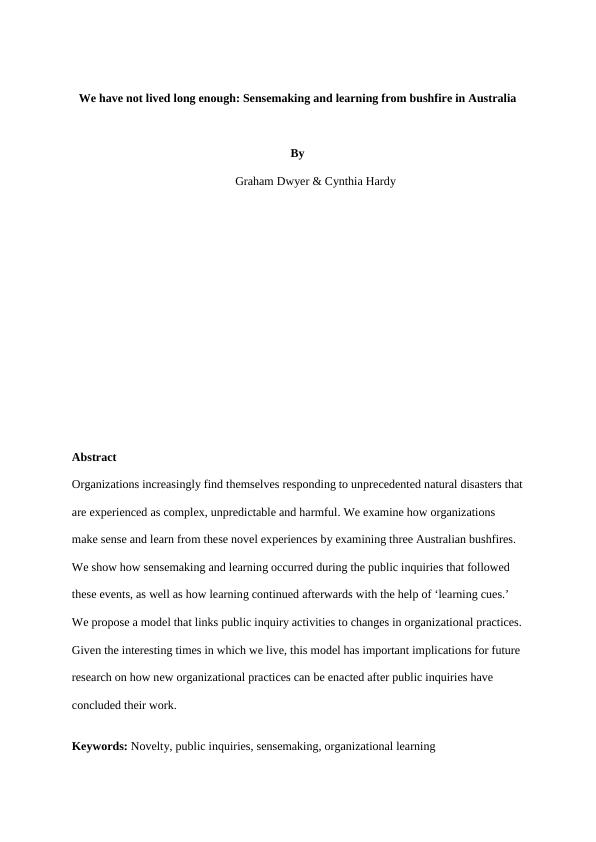
Introduction
Over the last decade, the earth’s natural environment has provoked a growing and
justifiable level of concern over our ability to cope with major catastrophes (Pelling, 2010).
Atmospheric scientists are attributing higher temperatures, wind speeds and moisture deficits
to climate change, which is subsequently causing natural disasters that have become more
frequent, complex and devastating (Birkman, 2006). Hence, in the last decade we have
witnessed earthquakes, flooding, droughts and bushfires becoming more frequent and more
damaging (Glade et al., 2010). Such natural disasters are proving to be a challenge for
emergency management practitioners, including government ministers, policy-makers, police
officers, fire fighters, weather forecasters and geospatial analysts. Despite being well
prepared, organizations still struggle to respond effectively to natural disasters (Mileti, 1999)
because their learning from previous events is undermined when new or unfamiliar
conditions unfold.
Natural disasters are what Weick (1988) refers to as high impact-low probability
events, meaning that they interact with actors, systems and routines in the organizational
environment in a manner that is often rapid, unpredictable, harmful and on an unprecedented
scale. Such disasters impose significant losses and damages on communities globally.
Nevertheless, and perhaps surprisingly, critics argue that they have received less scholarly
attention than ‘man-made’ crises in organizational, industrial or political contexts (Sellnow et
al., 2002). This study therefore looks specifically at the case of natural disasters to explore
how organizational sensemaking and learning unfold in situations where actors struggle with
novel conditions. It does so by examining the case of bushfire in Victoria, Australia.
In a normal year, during the summer months, Australia is prone to high levels of
bushfire risk and there are times when such risk is greatly exacerbated by the early onset of
summer, prolonged drought, high wind speeds and low humidity. These conditions mean that,
2
Over the last decade, the earth’s natural environment has provoked a growing and
justifiable level of concern over our ability to cope with major catastrophes (Pelling, 2010).
Atmospheric scientists are attributing higher temperatures, wind speeds and moisture deficits
to climate change, which is subsequently causing natural disasters that have become more
frequent, complex and devastating (Birkman, 2006). Hence, in the last decade we have
witnessed earthquakes, flooding, droughts and bushfires becoming more frequent and more
damaging (Glade et al., 2010). Such natural disasters are proving to be a challenge for
emergency management practitioners, including government ministers, policy-makers, police
officers, fire fighters, weather forecasters and geospatial analysts. Despite being well
prepared, organizations still struggle to respond effectively to natural disasters (Mileti, 1999)
because their learning from previous events is undermined when new or unfamiliar
conditions unfold.
Natural disasters are what Weick (1988) refers to as high impact-low probability
events, meaning that they interact with actors, systems and routines in the organizational
environment in a manner that is often rapid, unpredictable, harmful and on an unprecedented
scale. Such disasters impose significant losses and damages on communities globally.
Nevertheless, and perhaps surprisingly, critics argue that they have received less scholarly
attention than ‘man-made’ crises in organizational, industrial or political contexts (Sellnow et
al., 2002). This study therefore looks specifically at the case of natural disasters to explore
how organizational sensemaking and learning unfold in situations where actors struggle with
novel conditions. It does so by examining the case of bushfire in Victoria, Australia.
In a normal year, during the summer months, Australia is prone to high levels of
bushfire risk and there are times when such risk is greatly exacerbated by the early onset of
summer, prolonged drought, high wind speeds and low humidity. These conditions mean that,
2
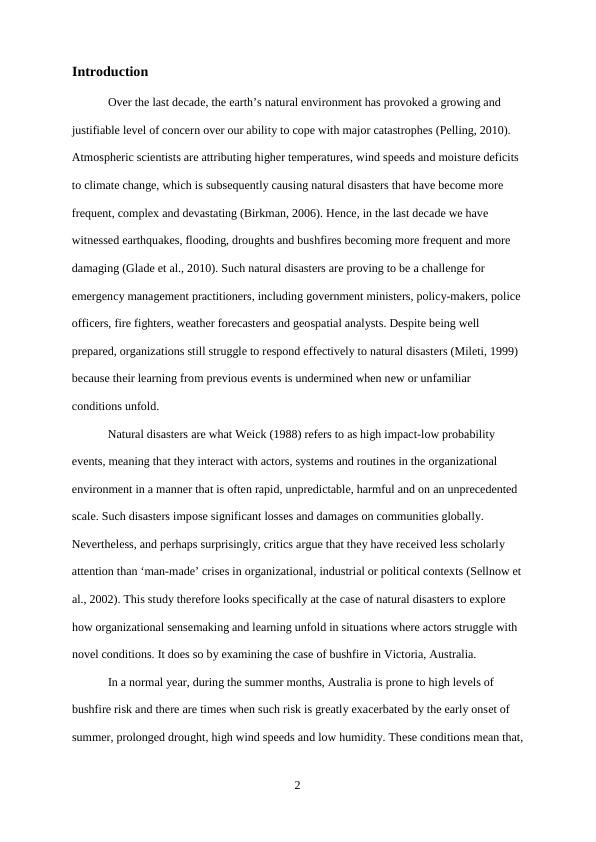
when fire is ignited, it creates what Colville et al. (2013: 1201) refer to as ‘circumstances that
are suffused with dynamic complexity’. Three such bushfires that continue to live in the
collective memory of Victorians are the focus of this paper: the Black Friday Fires, 1939 (71
lives lost); the Ash Wednesday Fires 1983 (75 lives lost: 47 in Victoria and 28 in South
Australia); and the Black Saturday Fires 2009 (173 lives lost). In each case, the organizations
responsible for managing these fires faced conditions that, despite their experience with
bushfires, were experienced as surprising, overwhelming and rare. They represented what
Weick (1993: 634) refers to as cosmology episodes, when ‘the sense of what is occurring and
the means to rebuild that sense collapse together’. Many of those who lived through them
express sentiments that echo Weick (1993: 634–635): ‘I’ve never been here before, I have no
idea where I am, and I have no idea who can help me’.
Our study shows how the inquiries that followed each of these fires constructed them
as novel, justifying the need for retrospective sensemaking and learning through deliberative
public inquiry processes. It shows how sensemaking and learning occurred during the
inquiries, as well as suggesting how ‘learning cues’ provided a basis for the double loop
learning that occurred during the inquiry to extend beyond it and led to changes in
organizational practices. In this way, our study responds to the call for research to explore the
theoretical and practical importance of how actors ‘learn to make sense, and make sense to
learn’ (Colville et al., 2013: call for papers). It makes the following contributions. First, it
provides an empirical exploration of sensemaking and learning associated with three natural
disasters that were described as unprecedented, dynamically complex events. Second, it
shows how both sensemaking and learning can occur through the process of holding public
inquiries. This is important because most of the theoretical focus on public inquiries has been
in relation to sensemaking; we know far less about whether and how inquiries engender
learning. Third, our study develops a general model that sets the stage for future research on
how new organizational practices come into being after inquiries have concluded their work.
3
are suffused with dynamic complexity’. Three such bushfires that continue to live in the
collective memory of Victorians are the focus of this paper: the Black Friday Fires, 1939 (71
lives lost); the Ash Wednesday Fires 1983 (75 lives lost: 47 in Victoria and 28 in South
Australia); and the Black Saturday Fires 2009 (173 lives lost). In each case, the organizations
responsible for managing these fires faced conditions that, despite their experience with
bushfires, were experienced as surprising, overwhelming and rare. They represented what
Weick (1993: 634) refers to as cosmology episodes, when ‘the sense of what is occurring and
the means to rebuild that sense collapse together’. Many of those who lived through them
express sentiments that echo Weick (1993: 634–635): ‘I’ve never been here before, I have no
idea where I am, and I have no idea who can help me’.
Our study shows how the inquiries that followed each of these fires constructed them
as novel, justifying the need for retrospective sensemaking and learning through deliberative
public inquiry processes. It shows how sensemaking and learning occurred during the
inquiries, as well as suggesting how ‘learning cues’ provided a basis for the double loop
learning that occurred during the inquiry to extend beyond it and led to changes in
organizational practices. In this way, our study responds to the call for research to explore the
theoretical and practical importance of how actors ‘learn to make sense, and make sense to
learn’ (Colville et al., 2013: call for papers). It makes the following contributions. First, it
provides an empirical exploration of sensemaking and learning associated with three natural
disasters that were described as unprecedented, dynamically complex events. Second, it
shows how both sensemaking and learning can occur through the process of holding public
inquiries. This is important because most of the theoretical focus on public inquiries has been
in relation to sensemaking; we know far less about whether and how inquiries engender
learning. Third, our study develops a general model that sets the stage for future research on
how new organizational practices come into being after inquiries have concluded their work.
3
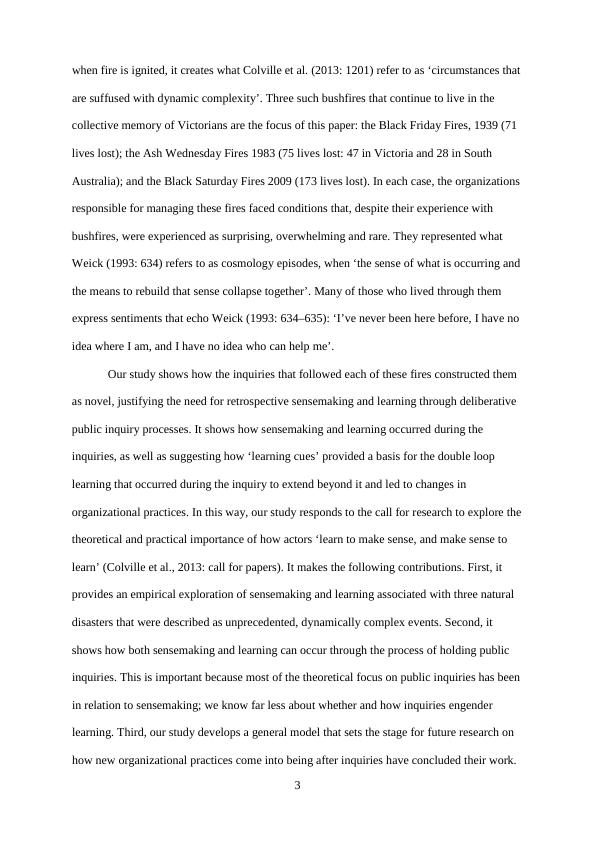
The remainder of this article reviews the literature on sensemaking and learning, with
a particular focus on public inquiry processes. It then explains the methods associated with
our qualitative, interpretive study of three bushfires. We then present the findings and
develop a model of sensemaking and learning. Finally, we discuss the implications.
Sensemaking
Sensemaking is ‘an ongoing process that creates an intersubjective sense of shared
meanings through conversation and non-verbal behavior in face to face settings where actors
seek to produce, negotiate and maintain a shared sense of meaning’ (Gephart et al., 2010:
284–285). It comprises two primary concepts (Weick, 1995). First, the sensing component is
built on the premise that actors draw on their lived experience, which is informed by their
identity, and influences how they respond to stimuli such as events, triggers and surprises
(Weick et al., 2005). Cognitively, actors struggle to respond in a meaningful way in an
environment where events are perceived to be novel, triggers are seen as sudden, and surprise
is experienced as continuous because existing cues and frames offer little or no insight into
what is unfolding (Colville et al., 2012; Colville et al., 2013). Second, the making component
is built on the premise that people attempt to enact or create, sensible environments, through
‘conversational and social practices’ (Gephart, 1993: 1469) about specific events to arrive at
an understanding about what is plausible, rather than objectively accurate (Weick, 1995).
Actors use questioning, framing, bracketing and storytelling to give meaning to
organizational issues in a way that provides the basis for action, even during crises and
disasters (Brown and Jones, 2000; Maitlis, 2005).
Crises and disasters trigger ‘sensebreaking’ moments where people lose their ability
to impose meaning on events and routines are interrupted (Mantere, et al., 2012). As a result,
they also provide powerful conditions for sensemaking as people ask: What is going on?
(Weick, 1993) This questioning provides the opportunity to create new meanings, allowing
4
a particular focus on public inquiry processes. It then explains the methods associated with
our qualitative, interpretive study of three bushfires. We then present the findings and
develop a model of sensemaking and learning. Finally, we discuss the implications.
Sensemaking
Sensemaking is ‘an ongoing process that creates an intersubjective sense of shared
meanings through conversation and non-verbal behavior in face to face settings where actors
seek to produce, negotiate and maintain a shared sense of meaning’ (Gephart et al., 2010:
284–285). It comprises two primary concepts (Weick, 1995). First, the sensing component is
built on the premise that actors draw on their lived experience, which is informed by their
identity, and influences how they respond to stimuli such as events, triggers and surprises
(Weick et al., 2005). Cognitively, actors struggle to respond in a meaningful way in an
environment where events are perceived to be novel, triggers are seen as sudden, and surprise
is experienced as continuous because existing cues and frames offer little or no insight into
what is unfolding (Colville et al., 2012; Colville et al., 2013). Second, the making component
is built on the premise that people attempt to enact or create, sensible environments, through
‘conversational and social practices’ (Gephart, 1993: 1469) about specific events to arrive at
an understanding about what is plausible, rather than objectively accurate (Weick, 1995).
Actors use questioning, framing, bracketing and storytelling to give meaning to
organizational issues in a way that provides the basis for action, even during crises and
disasters (Brown and Jones, 2000; Maitlis, 2005).
Crises and disasters trigger ‘sensebreaking’ moments where people lose their ability
to impose meaning on events and routines are interrupted (Mantere, et al., 2012). As a result,
they also provide powerful conditions for sensemaking as people ask: What is going on?
(Weick, 1993) This questioning provides the opportunity to create new meanings, allowing
4
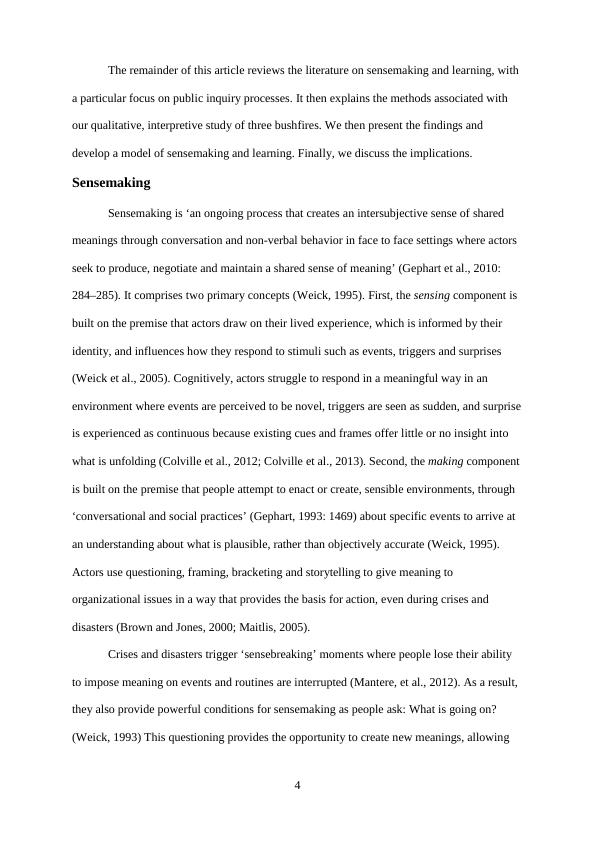
individuals to understand their experiences and, if there is consensus, facilitate co-ordinated
action (Weick, 1995). However, when individuals fail to understand the implications and
lessons to be gleaned from major crises and disasters, they are likely to engage in behaviors
with unintended or even tragic consequences because they are confronting novel situations
that they do not know how to gauge, process and manage (Weick, 1990).
Learning
The concept of organizational learning suggests that organizations learn from
previous experiences in the same way as individuals share mental modes that detect and
correct errors by altering the organization’s theory of action (Argyris and Schön, 1996). Such
learning is triggered when actors experience:
[A] surprising mismatch between expected and actual results of action and
respond to that mismatch through a process of thought and further action that
leads them to modify their images of organization or their understandings of
organizational phenomena and to restructure their activities so as to bring
outcomes and expectations into line, thereby changing organizational theory-
in-use (Argyris and Schön, 1978:16).
Hence, organizational learning occurs to the extent that actors extract knowledge from
systems at the individual and group levels of the organization (Argyris, 1976) so that change
can be made in an evidence-based manner through intuiting, interpreting, integrating and
institutionalizing (Crossan, et al., 1999) in ways that identify and correct errors.
Argyris (1976) argues that such learning occurs in two ways. First, single loop
learning occurs through error correction, but without altering the underlying governing values
of the system and/or organization. Second, double loop learning occurs when errors are
corrected by changing governing values and subsequent actions. Thus single loop learning
produces change within the existing organizational culture, while double loop learning leads
5
action (Weick, 1995). However, when individuals fail to understand the implications and
lessons to be gleaned from major crises and disasters, they are likely to engage in behaviors
with unintended or even tragic consequences because they are confronting novel situations
that they do not know how to gauge, process and manage (Weick, 1990).
Learning
The concept of organizational learning suggests that organizations learn from
previous experiences in the same way as individuals share mental modes that detect and
correct errors by altering the organization’s theory of action (Argyris and Schön, 1996). Such
learning is triggered when actors experience:
[A] surprising mismatch between expected and actual results of action and
respond to that mismatch through a process of thought and further action that
leads them to modify their images of organization or their understandings of
organizational phenomena and to restructure their activities so as to bring
outcomes and expectations into line, thereby changing organizational theory-
in-use (Argyris and Schön, 1978:16).
Hence, organizational learning occurs to the extent that actors extract knowledge from
systems at the individual and group levels of the organization (Argyris, 1976) so that change
can be made in an evidence-based manner through intuiting, interpreting, integrating and
institutionalizing (Crossan, et al., 1999) in ways that identify and correct errors.
Argyris (1976) argues that such learning occurs in two ways. First, single loop
learning occurs through error correction, but without altering the underlying governing values
of the system and/or organization. Second, double loop learning occurs when errors are
corrected by changing governing values and subsequent actions. Thus single loop learning
produces change within the existing organizational culture, while double loop learning leads
5
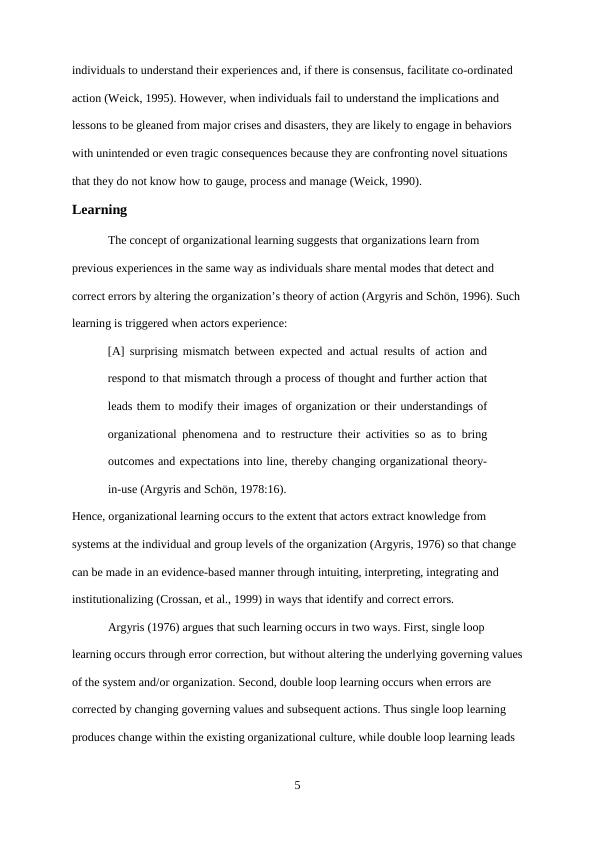
organizations to re-evaluate governing values and, potentially, change the culture and
practices more fundamentally. Moving from single loop learning to double loop learning
allows organizations to adjust their culture so that they can escape the clutches of ‘cultures of
entrapment’ which produce antilearning (Sutcliffe and Weick, 2003: 73). Antilearning occurs
when an organization’s members remain blind to incompetencies and inefficiencies, resulting
in inadequate performance that can harm the organization and its stakeholders (Argyris,
1993; Argyris and Schön, 1996).
Public inquiries, sensemaking and learning
Sensemaking and learning are both relevant to public inquiries. Research has found
that, in addition to the sensemaking that occurs (or fails to occur) during both natural and
man-made disasters (e.g., Weick, 1993), sensemaking also takes place in the public inquiries
that often follow (e.g., Brown, 2000; Brown and Jones, 2000; Gephart, 1984). In reviewing
what happened during the disaster or crisis, public inquiries make sense of it, often in ways
that establish accountability, rebuild public confidence and restore an organization’s
legitimacy where failure is evident. Much of this research, accordingly, emphasizes the
ceremonial and ritualized nature of inquiries and the way in which they create normalized
versions of the ‘truth’ (Brown, et al., 2015). Consequently, through rhetorical accounts,
public inquiries will often protect the dominance of powerful organizations, often at the
expense of individuals (e.g., Brown, 2004; Gephart, 1993).
Some researchers claim that the ritualized and political aspects of public inquiries
serve to inhibit learning (e.g., Buchanan, 2011). Nevertheless, public inquiries are generally
expected to result in some form of learning and lead to changes in subsequent practices in
order that organizations might respond more effectively in the future (Elliott, 2009).
Moreover, some studies have demonstrated that public inquiries of disasters do prompt
managers to implement change. For example, Bowman and Kunreuther (1988) show how
6
practices more fundamentally. Moving from single loop learning to double loop learning
allows organizations to adjust their culture so that they can escape the clutches of ‘cultures of
entrapment’ which produce antilearning (Sutcliffe and Weick, 2003: 73). Antilearning occurs
when an organization’s members remain blind to incompetencies and inefficiencies, resulting
in inadequate performance that can harm the organization and its stakeholders (Argyris,
1993; Argyris and Schön, 1996).
Public inquiries, sensemaking and learning
Sensemaking and learning are both relevant to public inquiries. Research has found
that, in addition to the sensemaking that occurs (or fails to occur) during both natural and
man-made disasters (e.g., Weick, 1993), sensemaking also takes place in the public inquiries
that often follow (e.g., Brown, 2000; Brown and Jones, 2000; Gephart, 1984). In reviewing
what happened during the disaster or crisis, public inquiries make sense of it, often in ways
that establish accountability, rebuild public confidence and restore an organization’s
legitimacy where failure is evident. Much of this research, accordingly, emphasizes the
ceremonial and ritualized nature of inquiries and the way in which they create normalized
versions of the ‘truth’ (Brown, et al., 2015). Consequently, through rhetorical accounts,
public inquiries will often protect the dominance of powerful organizations, often at the
expense of individuals (e.g., Brown, 2004; Gephart, 1993).
Some researchers claim that the ritualized and political aspects of public inquiries
serve to inhibit learning (e.g., Buchanan, 2011). Nevertheless, public inquiries are generally
expected to result in some form of learning and lead to changes in subsequent practices in
order that organizations might respond more effectively in the future (Elliott, 2009).
Moreover, some studies have demonstrated that public inquiries of disasters do prompt
managers to implement change. For example, Bowman and Kunreuther (1988) show how
6
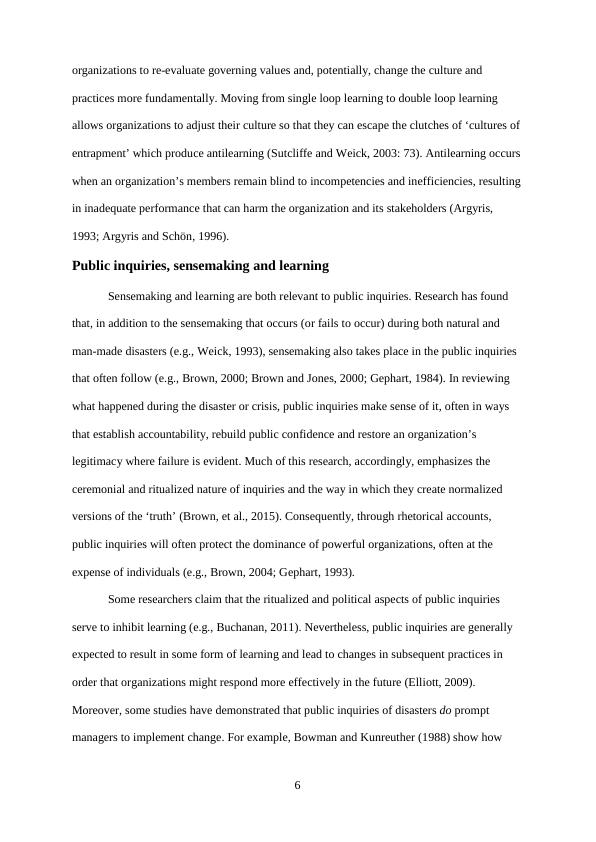
data generated from multiple public inquiries triggered safety management initiatives in a 500
Fortune chemical company. Similarly, Turner (1976: 381) demonstrates how ‘cultural
readjustment’ occurred in UK state organizations following the Aberfan coalmine accident in
Wales (1966-67), the Hixon level crossing collision in England (1968) and the Summerland
leisure complex fire in Isle of Man (1974). However, we still know relatively little about how
sensemaking and learning during a public inquiry lead to organizations being better prepared
for the future. This study therefore explores the relationship between sensemaking and
learning activities during public inquiry processes after dynamically complex events, as well
as examining the processes leading to changes in organizational practices that occur after
inquiries have run their course.
Methodology and research design
Our research is qualitative and interpretive insofar as it examines ‘the meanings in use
by societal members to explain how they directly experience everyday life realities’ and
examines how particular meanings become shared (Gephart, 2004: 457). We chose such an
approach because sensemaking and learning can be considered to be interpretive processes
(Argyris, 1978; Gephart, 1993; Maitlis, 2005; Brown et al., 2015) and we are interested in
how public inquiries create meanings for the events that give rise to them, as well as for the
changes that may follow them. We examine three case studies of bushfires and conduct a
textual analysis of the reports produced by three public inquiries. In doing so, we recognize
that a public inquiry report is:
an artefact that has resulted from authorial strategies of selection and omission
of material, and which makes use of rhetorical devices ... to present an (not
the only) understanding of events (Brown, 2000: 49).
Inquiries are ceremonial events with certain ritualized procedures (Gephart, 1984), embedded
in a particular cultural and legal context (Brown, 2000), whose aim is to produce accounts
7
Fortune chemical company. Similarly, Turner (1976: 381) demonstrates how ‘cultural
readjustment’ occurred in UK state organizations following the Aberfan coalmine accident in
Wales (1966-67), the Hixon level crossing collision in England (1968) and the Summerland
leisure complex fire in Isle of Man (1974). However, we still know relatively little about how
sensemaking and learning during a public inquiry lead to organizations being better prepared
for the future. This study therefore explores the relationship between sensemaking and
learning activities during public inquiry processes after dynamically complex events, as well
as examining the processes leading to changes in organizational practices that occur after
inquiries have run their course.
Methodology and research design
Our research is qualitative and interpretive insofar as it examines ‘the meanings in use
by societal members to explain how they directly experience everyday life realities’ and
examines how particular meanings become shared (Gephart, 2004: 457). We chose such an
approach because sensemaking and learning can be considered to be interpretive processes
(Argyris, 1978; Gephart, 1993; Maitlis, 2005; Brown et al., 2015) and we are interested in
how public inquiries create meanings for the events that give rise to them, as well as for the
changes that may follow them. We examine three case studies of bushfires and conduct a
textual analysis of the reports produced by three public inquiries. In doing so, we recognize
that a public inquiry report is:
an artefact that has resulted from authorial strategies of selection and omission
of material, and which makes use of rhetorical devices ... to present an (not
the only) understanding of events (Brown, 2000: 49).
Inquiries are ceremonial events with certain ritualized procedures (Gephart, 1984), embedded
in a particular cultural and legal context (Brown, 2000), whose aim is to produce accounts
7
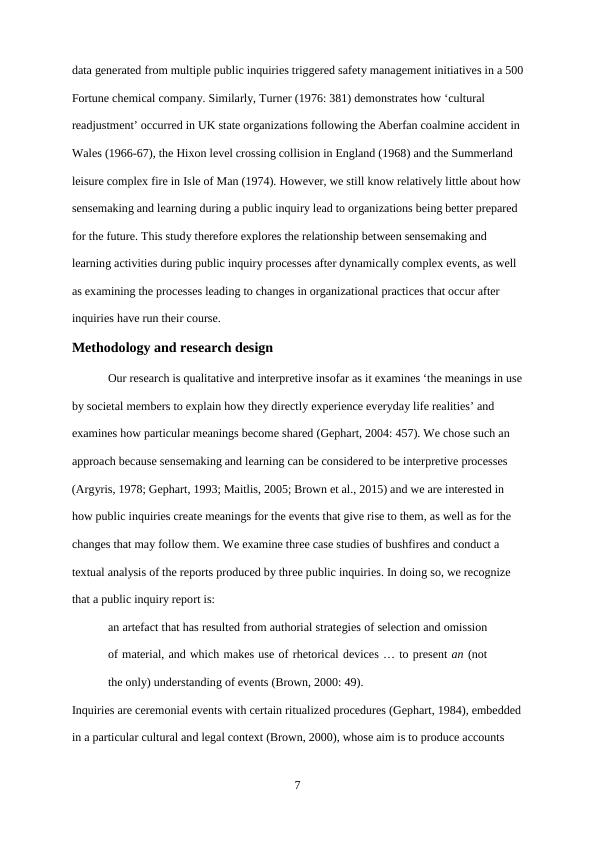
that are plausible, verisimilitudinous, and authoritative (Brown, et al., 2012). Accordingly,
when we infer instances of sensemaking and learning from such reports, we do not claim that
they are ‘correct’ or ‘accurate’ in their representation of events. Instead, we suggest that
sensemaking and learning are ‘manifest in language, text and discourse including
conversations, vocabularies, utterances and documents’ (Gephart, 1997: 588), and can
therefore be discerned from the analysis of such language.
In addition to inquiry reports, we also analyze other texts that were related to the
inquiries but produced afterwards as a form of ‘intertextuality’ (Fairclough, 1992). When
texts draw on, react to and transform other texts, certain conclusions can be drawn. For
example, in our analysis, when public inquiry reports were referred to in other texts, we were
able to make inferences as to whether learning may have taken place. Similarly, insofar as
these other texts reported on changes made (or not made) following the inquiries, they
provided us with evidence for subsequent changes in organizational practices. In analyzing
these texts in this way, we make no inference as to whether the learning was ‘correct’ or
whether these changes actually worked. Nor do we use these texts as a form of triangulation,
whereby multiple data sources are assumed to represent reality more accurately. Rather, we
acknowledge that the views offered in these other texts are subjective and that each genre has
its own institutionalized protocols, which shape the rhetoric of their accounts. Nonetheless,
these data are still useful to explore learning during and after public inquiries. Finally, we
recognize that this paper is, itself, an attempt to craft an authoritative account and we deploy
rhetoric in ways consistent with the genre of a scholarly article in order to appeal to our
particular audience (cf. Currie and Brown, 2003).
We selected the three case studies – the Black Friday Fires in 1939, the Ash
Wednesday Fires in 1983 and the Black Saturday Fires in 2009 – because they were
perceived to be three of the most significant and damaging natural disasters in Victoria,
during which a considerable number of lives and properties were lost (Griffiths, 2010). It
8
when we infer instances of sensemaking and learning from such reports, we do not claim that
they are ‘correct’ or ‘accurate’ in their representation of events. Instead, we suggest that
sensemaking and learning are ‘manifest in language, text and discourse including
conversations, vocabularies, utterances and documents’ (Gephart, 1997: 588), and can
therefore be discerned from the analysis of such language.
In addition to inquiry reports, we also analyze other texts that were related to the
inquiries but produced afterwards as a form of ‘intertextuality’ (Fairclough, 1992). When
texts draw on, react to and transform other texts, certain conclusions can be drawn. For
example, in our analysis, when public inquiry reports were referred to in other texts, we were
able to make inferences as to whether learning may have taken place. Similarly, insofar as
these other texts reported on changes made (or not made) following the inquiries, they
provided us with evidence for subsequent changes in organizational practices. In analyzing
these texts in this way, we make no inference as to whether the learning was ‘correct’ or
whether these changes actually worked. Nor do we use these texts as a form of triangulation,
whereby multiple data sources are assumed to represent reality more accurately. Rather, we
acknowledge that the views offered in these other texts are subjective and that each genre has
its own institutionalized protocols, which shape the rhetoric of their accounts. Nonetheless,
these data are still useful to explore learning during and after public inquiries. Finally, we
recognize that this paper is, itself, an attempt to craft an authoritative account and we deploy
rhetoric in ways consistent with the genre of a scholarly article in order to appeal to our
particular audience (cf. Currie and Brown, 2003).
We selected the three case studies – the Black Friday Fires in 1939, the Ash
Wednesday Fires in 1983 and the Black Saturday Fires in 2009 – because they were
perceived to be three of the most significant and damaging natural disasters in Victoria,
during which a considerable number of lives and properties were lost (Griffiths, 2010). It
8

End of preview
Want to access all the pages? Upload your documents or become a member.
Related Documents
Annotated Bibliography on Catastrophic Bushfires in Australialg...
|8
|1187
|1
